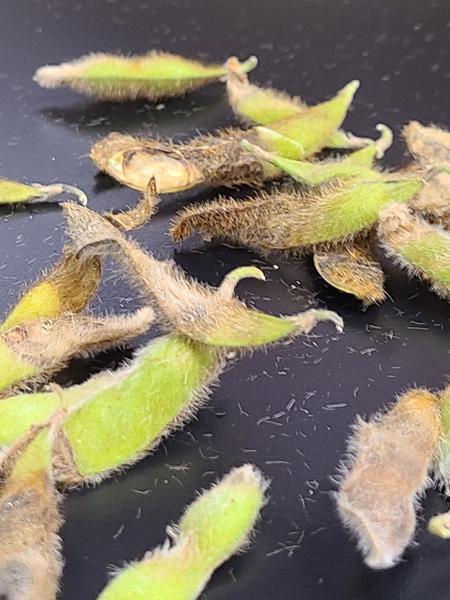Anthracnose
- Scientific Name(s)
- Colletotrichum truncatum
- Type
- Disease
- Leaf Condition
- Distorted, Complete Necrosis, Wilted, Brittle, Leaf Spot
- Leaf Color
- Black Irregular Spots, Patchy Yellow And Brown Areas, Marginal Chlorosis, Interveinal Chlorosis
- Leaf Location
- Entire, Upper, Lower, Young, Mature
- Pod Condition
- Lesion
- Seed
- Aborted, Shriveled
- Main Stem
- Necrotic Spots, Internal Discoloration
- Petioles Condition
- Distorted, Lesion, Death
- Plant Size
- Stunted
- Field Distribution
- Random, Low Areas, Localized Area
- Prior Environmental
- Rain, High Temp
- Season
- Flowering, Pods Present
- Cropping System
- Soybean Followed By Soybean, Conventional Till, Reduced Till
Introduction
Anthracnose is a fungal disease affecting maturing soybean stems and pods. Late season occurrence may affect crop stand, yield, and seed quality. Symptoms may be mistaken for pod and stem blight (Diaporthe phaseolorum), however symptoms differ and both diseases can be observed together, late season.
Pathogen
The fungus Colletotrichum truncatum is the most common causal agent of anthracnose; however, several other species of Colletotrichum have been identified. The fungus spreads via asexual spores (conidia), and produces black fruiting bodies (acervuli) that develop spines (setae) on the stems when plants are mature.
Symptoms
In the field, disease usually is present in patches where defoliation and wilting may be observed. Anthracnose presents with red to brown dark irregular lesions on stems, pods, and petioles (Figure 1). Affected petioles may present a “shepherd’s crook” appearance or develop brown cankers, and later premature defoliation. Later during infection, fruiting bodies can be observed as black dots (acervuli) containing spines (setae) on the external surface of infected tissue. Pod infection may result in no seed due to fungal colonization of the entire pod. Leaf symptoms include vein reddening and leaf rolling.
Life Cycle and Favorable Conditions for Disease
Anthracnose is favored by warm wet weather, and plants may be infected at any point during the growing season. Colletotrichum spp. overwinter in crop debris and may be seedborne. Conidia are dispersed from acervuli (black and round fruiting bodies that form on external infected tissue) infecting soybean stems, petioles, leaves, and pods. At the end of the growing season, crop debris left in the field harbor inoculum that may start the disease epidemic in the next growing season with soybeans.
Management
Soybean varieties may differ in susceptibility to anthracnose. Fungicide-treated seed may reduce early-season infections in areas with high inoculum pressure. Foliar fungicides applied in early reproductive stages may reduce disease; however, there are few situations where fungicide applications are profitable for anthracnose. Crop rotation and burying infected crop debris may promote inoculum breakdown and reduce disease incidence in future stands.
Useful Resources
The Crop Protection Network Fact Sheet for anthracnose has more images and descriptions for diagnosis help.
The NC State University Plant Disease and Insect Clinic provides diagnostics and control recommendations.
The NC State Extension Plant Pathology portal provides information on crop disease management
The North Carolina Agricultural Chemicals Manual provides pesticide information for common diseases of North Carolina. The manual recommendations do not replace those described on the pesticide label, and the label must be followed.
Acknowledgements
This factsheet was prepared by the NC State University Field Crops and Tobacco Pathology Lab in 2020.
- Check out our Facebook and our Twitter!



